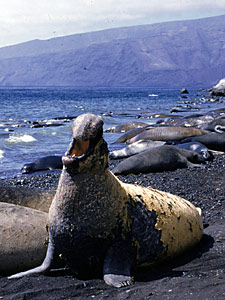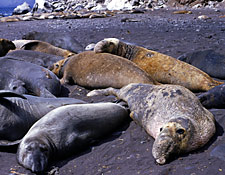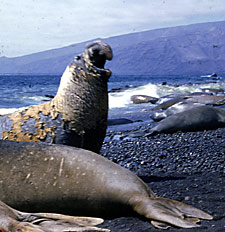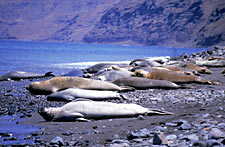![[Ocean Oasis Field Guide]](images/bnr-oo-field.gif)

![[Ocean Oasis Field Guide]](images/bnr-oo-field.gif) |  |
|
Mirounga angustirostris PHOCIDAE (True Seal Family) | |
DescriptionThe northern elephant seal is named for its size and the trunk-like snout of mature bull males. It is one of the largest of the pinnipeds. The seal's coat may be tan, brown, or grayish on top with a lighter colored belly; it has no spots. When the elephant seal molts, skin peels off along with the hair. The elephant seal, along with other members of the true seal family Phocidae, has no external ears. It swims with its hind flippers, which are always extended behind and cannot be curled forward. The front flippers are relatively small, with flexible digits that are used for scratching and for scooping sand over the body. Size: Males usually measure 4.5 meters (14-16 feet), but may be as long as 5 meters (17 feet), and weigh as much as 1,800 kg (5,000 pounds). Females (cows) are usually 2-3 meters (6-10 ft.) long, and weigh about 750 kg (2,000 pounds). Range and HabitatRange: The modern range of this species extends from about Point Reyes near San Francisco to Cedros Island in Baja California. It is not considered migratory. During the breeding season, it appears on many islands off the coast of California and Mexico, including the Farallones, Año Nuevo, San Miguel, Santa Cruz, San Nicholas, San Clemente, Islas Coronado, Guadalupe, and San Benito. During the non-breeding season, male elephant seals have been found as far north as southeastern Alaska, and females as far west as Hawaii. Habitat: The elephant seal is almost entirely aquatic, coming ashore primarily to breed. Its range is mostly in warm waters. Natural HistoryBehavior: The elephant seal is a powerful swimmer and well adapted to an aquatic life. The seals may be solitary at sea, but become very social on the beach. Even during nonbreeding times of the year, they will lie close together on the sand. The males arrive at rookery sites in early December, and remain throughout the breeding season without going to sea to feed. Because they move slowly and awkwardly on land, the males cannot defend large territories or large numbers of females. Unlike other seals, which may have harems averaging 40 cows, a dominant bull elephant seal may have only a dozen cows within his territory. The large overhanging snout of mature males appears to be used only for territorial defense during the breeding season. When relaxed, the snout measures nearly a foot long and hangs over the mouth (Ingles). When inflated, the snout is used to snort out a loud, resonant challenge to other males. Reproduction: The females arrive at the rookeries in late December. They give birth within a week, usually to a single pup. A day or two after the birth, the females are bred by the dominant male within the territory they've selected. Gestation lasts about 350 days. The greatest threat to the young pups is the heavy-bodied adult. Males, which entirely ignore the presence of the pups, sometimes crush them. Females will bite and sometimes kill pups that are not their own. Diet: Elephant seals presumably feed in deep water and eat squid, and fish, including small sharks and rays. They can fast as long as three months. Predators: Scars and wounds found on adult elephant seals indicate that they are attacked by large sharks, particularly the great white shark, and orcas. Conservation StatusElephant seals once ranged from Magdalena Bay Baja California to the San Francisco Bay region. During the nineteenth century, they were hunted to near extinction, and the entire population of Northern elephant seals was reduced to a small herd of less than 100 individuals on Isla de Guadalupe. The protection of this species during the twentieth century resulted in a gradual recovery, and the population spread north to other islands and some mainland beaches. The current population has been estimated at over 150,000. |




|
Text by Linda West in consultation with Dr. Thomas Deméré
Top three photos of Elephant Seals on Guadalupe Island by George Lindsay
Bottom photo by Jon Rebman
Field Guide |
Site Index |
Ocean Oasis Introduction
|
|
© 2000 San Diego Natural History Museum |